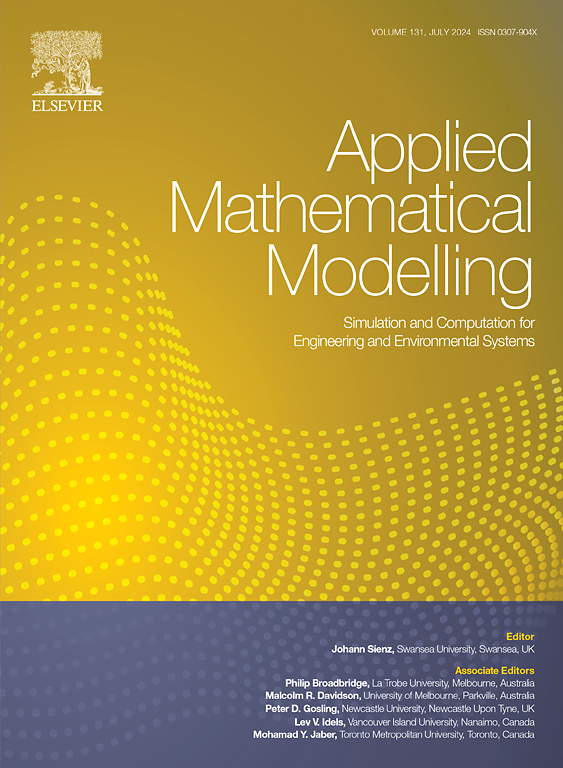加性和乘性色噪声激励下弹性约束轮对系统的随机稳定性
IF 4.4
2区 工程技术
Q1 ENGINEERING, MULTIDISCIPLINARY
引用次数: 0
摘要
考虑轨道不平整度和轮对自身控制参数等激励因素的影响,研究了弹性约束轮对系统的非线性动力响应。建立了乘性和加性有色噪声激励下轮对系统的动力学模型,重点研究了系统的稳定性和分岔行为。应用拟不可积Hamilton系统的随机平均方法,将模型简化为一维Itô随机微分方程。基于奇异边界理论和三指数方法,从理论上分析了系统的稳定性和分岔的类型和条件。通过数值模拟分析了各参数对系统稳定性、随机分岔临界速度以及概率密度函数拓扑变化的影响。结果表明,系统的稳定性和分岔类型主要由内部激励决定。控制参数的变化导致不稳定临界速度的变化,并改变分岔的类型。我们通过时程图、庞卡罗剖面和分岔图揭示了系统的分岔趋势。随着参数的变化,系统表现出丰富的动态分岔特性。值得注意的是,当受多参数影响时,系统在双参数平面上以倍周期分岔的方式从周期状态过渡到混沌状态,分岔结构随着参数的变化而发生相应的变化。本文章由计算机程序翻译,如有差异,请以英文原文为准。
Stochastic stability of an elastically constrained wheelset system under additive and multiplicative color noise excitations
This study investigates the nonlinear dynamic response of an elastically constrained wheelset system, considering the impacts of excitation factors such as track irregularities and control parameters of the wheelset itself. A dynamic model of the wheelset system is established under both multiplicative and additive colored noise excitations, focusing on the system's stability and bifurcation behavior. By applying the stochastic averaging method for quasi-non-integrable Hamilton systems, the model is simplified to a one-dimensional Itô stochastic differential equation. Based on the singular boundary theory and the three-exponential method, the types and conditions of the stability and bifurcation of the system are assessed theoretically. Numerical simulations are conducted to analyze the effects of various parameters on the system's stability, the critical speed for stochastic bifurcation, and the changes in the topology of the probability density function. The results demonstrate that the system's stability and the type of bifurcation are primarily governed by internal excitations. Variations in control parameters lead to changes in the critical speed for instability and alter the type of bifurcation. We reveal the bifurcation trends of the system through time history diagrams, Poincaré sections, and bifurcation diagrams. The system exhibits rich dynamic bifurcation characteristics as parameters vary. Notably, when affected by multiple parameters, the system transitions from periodic to chaotic states in the period-doubling bifurcation manner on the two-parameter plane, with bifurcation structures changing accordingly with parameter variations.
求助全文
通过发布文献求助,成功后即可免费获取论文全文。
去求助
来源期刊

Applied Mathematical Modelling
数学-工程:综合
CiteScore
9.80
自引率
8.00%
发文量
508
审稿时长
43 days
期刊介绍:
Applied Mathematical Modelling focuses on research related to the mathematical modelling of engineering and environmental processes, manufacturing, and industrial systems. A significant emerging area of research activity involves multiphysics processes, and contributions in this area are particularly encouraged.
This influential publication covers a wide spectrum of subjects including heat transfer, fluid mechanics, CFD, and transport phenomena; solid mechanics and mechanics of metals; electromagnets and MHD; reliability modelling and system optimization; finite volume, finite element, and boundary element procedures; modelling of inventory, industrial, manufacturing and logistics systems for viable decision making; civil engineering systems and structures; mineral and energy resources; relevant software engineering issues associated with CAD and CAE; and materials and metallurgical engineering.
Applied Mathematical Modelling is primarily interested in papers developing increased insights into real-world problems through novel mathematical modelling, novel applications or a combination of these. Papers employing existing numerical techniques must demonstrate sufficient novelty in the solution of practical problems. Papers on fuzzy logic in decision-making or purely financial mathematics are normally not considered. Research on fractional differential equations, bifurcation, and numerical methods needs to include practical examples. Population dynamics must solve realistic scenarios. Papers in the area of logistics and business modelling should demonstrate meaningful managerial insight. Submissions with no real-world application will not be considered.
 求助内容:
求助内容: 应助结果提醒方式:
应助结果提醒方式:


